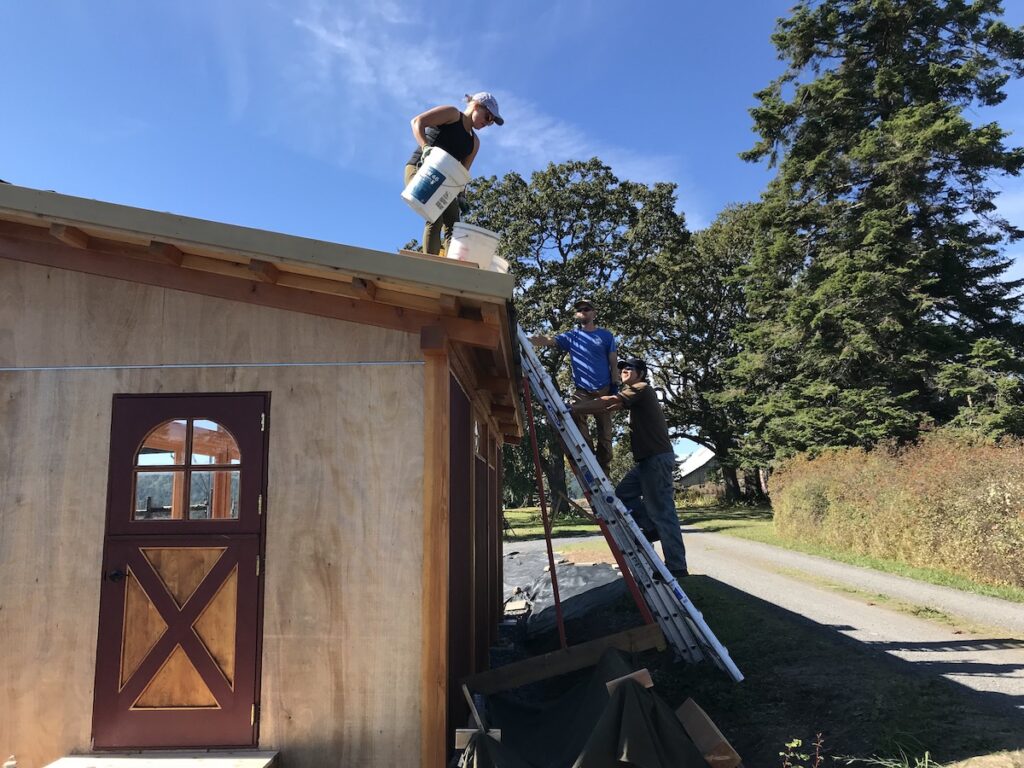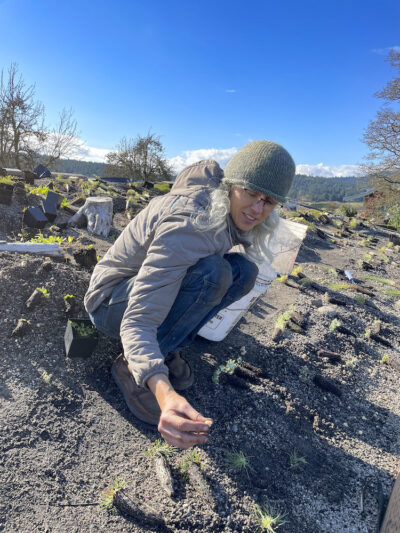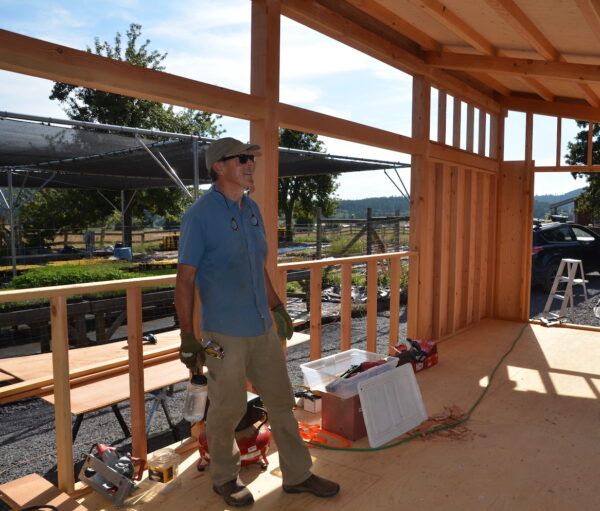
Bucket brigade hoisting tons of soil and gravel for the new shed’s “green roof” last fall

Eliza Habegger planting native species on the green roof
Ever since the Salish Seeds Nursery was established at the Preservation Trust’s Red Mill Farm Preserve on San Juan Island in 2015, keeping tools, seeds, and workers out of the Pacific Northwest weather was a challenge for the San Juan County Conservation Land Bank, which manages the nursery.
“We didn’t have enough space, and the space we had—in an old, ramshackle outbuilding—was a long walk from the nursery,” said Eliza Habegger, a land steward with the Land Bank and manager of the Salish Seeds Nursery. “It was all just very inefficient and frustrating.”
This year, a new Salish Seeds work shed will complete its first full summer, having been thoroughly used since the day construction was completed last fall. Even years before its creation, the idea of the shed brought people together as they sought an affordable solution as the nursery grew.
Eventually, amidst a pandemic, Eliza and Pete Kilpatrick, a board member of the Preservation Trust and the founder of Ravenhill Construction on San Juan Island, were the two major players whose stars aligned, allowing ideas for a new shed to come to fruition.
Eliza called Pete, and Pete agreed to scope out the project.
“Pete got here and said, ‘I can build that, it’ll be fun!’ and that was really fabulous,” Eliza said. “At the time this was happening, we didn’t know how we’d find a builder for our project. There are a lot of construction projects going on right now, and we just didn’t think anybody would want to build our weird little shed.”
The “weirdness” factor came mainly from the planners’ desire to endow the structure with a living, “green roof.” Accordingly, Pete beefed up the framing so it could bear extra weight. But not by quite enough, as it turned out.
To fill the live garden bed on the roof, 7.5 cubic yards of soil were hoisted aloft via a “bucket brigade” of people climbing a ladder carrying countless buckets full of soil. The immense weight led to some initial sagging in the roof, which prompted Pete to install additional rafters so the shed could stand strong for years to come.

Pete Kilpatrick, shed builder extraordinaire
“I think the shed’s great, it’s like Eliza’s little palace out there,” Pete said. “It gives a much more permanent identity to the Salish Seeds Poject. It’s like they’re in their home now.”
With the materials shortage that arose during the pandemic, Pete utilized his workshop to construct windows and doors. One day, while on the San Juan Islands Buy, Sell, Trade Facebook page, he found a Dutch door that he’d built shortly after moving to the islands in the 1980s, so he pounced on it, rebuffed it, and installed it in the shed.
“I thought it was ancient history,” Pete said. “I’m glad I could find it and resurrect it.”
Resurrected Dutch doors and all, the shed now stores nursery equipment and provides shelter for people to work in inclement weather, as well as a controlled space for drying and processing seeds.
“It’s a purpose-built structure to address a variety of needs,” Eliza said. “This shed has transformed this operation. It’s a huge boost for what this project was meant to be, which is increasing native plants and seeds so people can grow them.”
Thanks to the efforts from folks like Pete donating their time and skills and the cross-organizational fundraising efforts from the Land Bank and SJPT, the shed has bloomed into what the nursery always wanted but never had—until now.
“Volunteer efforts are important,” Pete said. “A great part of our island community is how many great projects get done with volunteer labor and efforts. It’s wonderful to be a part of that pool.”
